Working with ArtsWorcester, Clark students share research with community
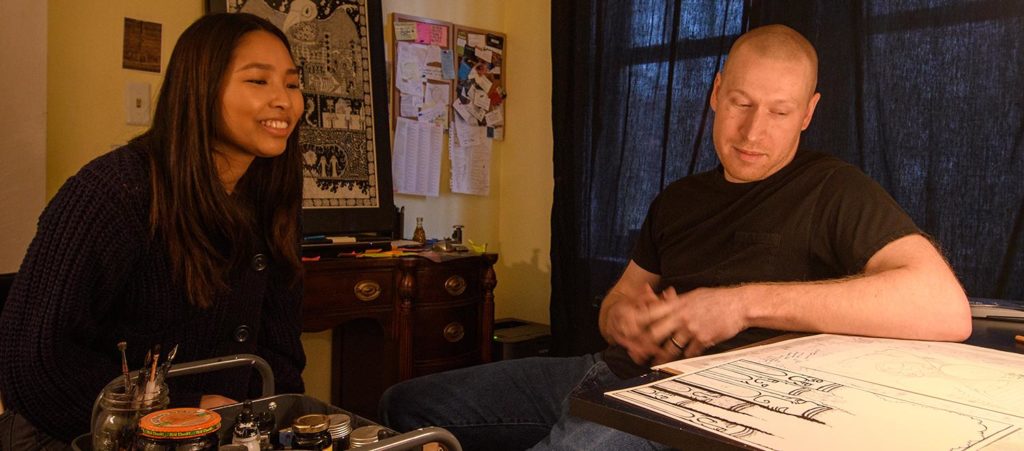
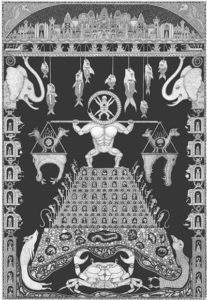
When the Worcester Art Museum opens a five-month-long exhibition of local artist James Dye’s work on April 7, the art criticism of two Clark University undergraduates also will be on display.
Alyssa Pelletier ’19 and Pauline Wan ’20 interviewed and observed Dye in his studio to understand his artistic process, background, and influences. Their resulting essays – Pelletier’s appears in a pamphlet to be distributed at the museum, and Wan’s will be published soon in Worcester Magazine – aim to help audiences similarly access Dye’s work.
The students’ 750-word essays are the culminating project in “Art, the Public, and the History of Worcester: ArtsWorcester,” a Problems of Practice (POP) course taught last fall by Kristina Wilson, professor of art history. An integral part of Clark’s undergraduate curriculum, POP courses allow undergraduate students to gain internship-like experiences outside the classroom, practicing skills and networking with professionals.
“The goal of the course was for students to work with an off-campus organization where art history is practiced professionally every day – in this case, ArtsWorcester – and to apply their art history skills to a project that would have a public face,” Wilson says. The partnership with ArtsWorcester was funded in part through a grant to Clark from the Mellon Foundation.
Pelletier, Wan and their 10 classmates researched contemporary artists to be featured in eight solo exhibitions produced by ArtsWorcester this spring. Seven of the exhibitions are being hung at the organization’s three city galleries – The Aurora, The Hadley, and The Hanover. Dye won the Sally R. Bishop Prize for Best in Show for his ink drawing, “Temples of the Burdened Host,” at ArtWorcester’s 17thBiennial in 2017. The prize includes his solo exhibition, “Exploring the Myths of James Dye,” at the Worcester Art Museum.
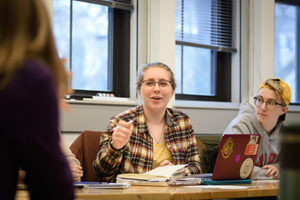
“Since the start of his career, Dye’s work has investigated mythology and its essential role in our existence,” Pelletier writes in her essay. “Inspired by Carl Jung’s psychoanalytic theory of the Collective Unconscious, Dye uses mythology to explore humanity’s communal memory and shared experiences.”
“She made me sound really good,” Dye joked during a recent tour of his studio, just blocks from Clark’s campus. Pelletier and Wan’s interviews forced him to verbalize his thoughts about his work. “I’m not always great at that,” he admitted. “It was good to get some practice.”
Pelletier said the course’s practice-oriented approach allowed her to “deeply connect with the material and dive into it for months. Not only did I get the chance to go out into the world, but I also met James Dye, I visited his studio, and I learned how to interview someone. I learned all these skills I can carry into the future.”
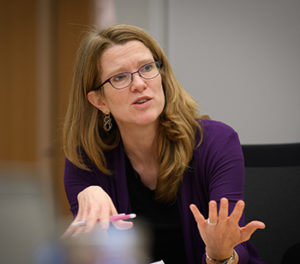
Her classmate, Alice Dillon ’19, appreciated the experience she gained in writing a polished, professional piece about Grafton photographer James Hunt.
“In all my other seminars, the final project is a 15-page paper, and it’s only read by one person, my professor, and then it’s done,” Dillon says. “But with this POP course and another one I took, it’s a very concentrated piece of writing that we focused on for weeks, and then it got put out into the real world, where hundreds and maybe thousands of people read it, which is so much more fulfilling than one person reading one paper.”
In a spring 2017 POP course with Janette Greenwood, professor of history, Dillon researched and wrote a concise, explanatory label that accompanied a photograph in the Worcester Art Museum’s recent exhibition, “Rediscovering an American Community of Color: The Photographs of William Bullard.”
For Wilson’s course, Dillon wrote a pamphlet focused on Hunt, whose work will be displayed in an exhibition titled “Under the Highway: Blackstone River Landscapes,” running June 27 through Oct. 30 at ArtsWorcester’s gallery in The Hanover Theatre.
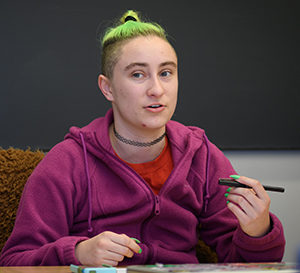
Autumn Perez ’18 also interviewed Hunt and researched his work, writing a column to be published in Worcester Magazine. Producing a professional publication instead of a term paper “holds you to the public standard, as opposed to your own standard,” she says. “This course has helped me actualize a piece of work for the public, a work that I can be really proud of.”
Wan took Wilson’s course to gain more writing skills. “It was really interesting to write about art in a non-academic context for the first time,” she says. “I had to change my way of writing.”
The students also came away with a sense of Worcester’s thriving arts community. In its recent Spring Arts Preview, Worcester Magazine took note of the city’s appetite for art, counting more than 40 exhibits and exhibitions through early summer.
“There definitely is a deep sense of community among artists in Worcester, and organizations like ArtsWorcester have helped foster that,” says Pelletier, who won Clark’s Barth Summer Internship Award to work at the organization in 2017. Dye is a testament to that community, she adds. “Hanging on the walls in his house are photos from Stephen DiRado [professor of practice in the Department of Visual and Performing Art] and other works by Worcester artists. He also volunteers at ArtsWorcester.”
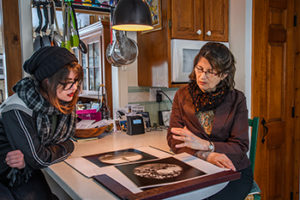
Wilson’s course helped the students – most of whom are majoring in art history – figure out how they might apply their degrees.
“Besides practicing artists, we interacted with other people who work in and run galleries and museums,” Pelletier said. “It’s interesting to see people in Worcester with art history degrees and what they’re doing with their degrees. As a student, it’s been really empowering that there are professionals who value my input.”
Juliet Feibel, executive director of ArtsWorcester, appreciated the students’ involvement. “This project represents some of the finest qualities of public scholarship in the arts and humanities, with students engaged in meaningful research that is then shared with the city at large,” Feibel notes. “The students’ positioning of our artists in contemporary art history brought those artists a new understanding of their own work. It was a huge boon to their artistic practices – and of great benefit to our visitors, who are snapping up the students’ essays, reading them on the spot, and then taking them home with them.
“I should add that it was also great fun for all involved, and the curiosity and initiative shown by the Clark students made a huge impression on the artists.”


